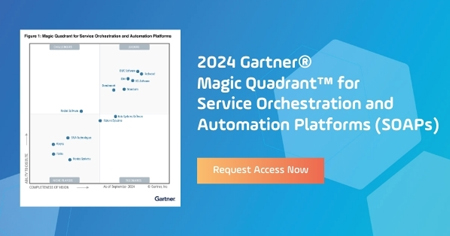Exploring DevOps Automation Integrations for the UAC
Integration between UAC and development tools helps you automate DevOps processes in your CI/CD pipeline — and control them all from one single pane of glass.

Since its inception in the late 2000s, DevOps has become a widely accepted approach. Its fundamental principles of collaboration, automation, and continuous delivery have now become so mainstream that Gartner even removed DevOps from the I&O Automation Hype Cycle in 2021, saying:
"DevOps has matured in its adoption and capabilities across the Gartner client base and, as such, is no longer tracked as an innovation. It remains critical for I&O to continue to implement practices and develop capabilities with DevOps both for its own purposes and in support of partner organization initiatives."
The prevalence of DevOps-specific tools hasn't made it any easier to do it well. A strong, collaborative culture is critical to ward off destructive tool proliferation, random acts of automation, and miscommunications between teams.
A service orchestration and automation platform (SOAP) helps connect all the dots. SOAPs use proven agent technology and modern API integrations to quickly (and securely) connect and control the automated processes that drive the entire DevOps toolchain. These integrations between SOAPs and developer tools allow software developers, cloud architects, sysadmins, and IT Ops alike to reach into and control workflows and automated processes while providing visibility – all from one central platform.
Keep scrolling to see how a SOAP — like the Stonebranch Universal Automation Center (UAC) — can help you centrally manage your sprawling DevOps toolchain, and what role integrations play in securely connecting those tools.
Continuous Deployment Means Continuous Automation
SOAPs easily integrate with third-party technologies — whether on-premises, in the cloud, or containerized — in a way their workload automation (WLA) predecessors simply can't. SOAPs securely integrate your entire DevOps toolchain — existing and future — to operate as a single unified force, including:
- Version control tools like GitHub
- Container management tools like Docker, Kubernetes, and Red Hat OpenShift
- Configuration management tools like Ansible
- CI/CD automation tools like Jenkins
The list goes on… SOAPs also automate tools for continuous testing, artifact management, change management, and more.
Stonebranch Connects Dev and Ops
According to Gartner, "I&O automation is the catalyst that drives quality and agility as organizations adopt cloud computing and DevOps practices, and integrate AI capabilities." DevOps teams rely on modern SOAPs like the Stonebranch UAC to:
- Control and automate deployments from the development side to operations
- Eliminate random acts of automation, such as point automations and custom scripts
- Integrate legacy systems into container-based DevOps processes — without redesigning business process logic
- Ensure compliance, security, and cost-efficiency throughout the entire software development lifecycle (SDLC)
In other words, the pre-built integrations available in the Stonebranch Integration Hub are designed to support your DevOps evolution. Plus, with the speed by which new integrations may be built, you have the flexibility to adapt to the constantly changing landscape of DevOps tools.
Here's a sampling of what's currently available in the hub's DevOps and Container categories:
Container Orchestration and Automation
UAC Solution Pack: Dynamic Container File Monitoring and File Transfer
This integration provides a dynamic file monitoring and file transfer solution for containerized applications running in any container-management solution such as Docker, Kubernetes, and Red Hat OpenShift.
Docker
Docker Compose: Support to Build, Up, Down, Start, Stop Docker Compose Functions
Manage Docker Compose functions from the Stonebranch UAC.
Docker Container: Support for Create, Start, Stop, Remove Containers and Run a Command in a Running Container
Automate Docker functions for Docker Containers in the Stonebranch UAC.
Docker Image: Support to Build, Remove, Pull, Push and Tag Image Functions
Orchestrate Docker functions for Docker Images in your UAC automation workflows.
GitHub
GitHub: Automated Import / Export
Automate the transfer of any workload object — such as tasks, calendars, scripts, and triggers — to and from GitHub. DevOps teams often use this integration to propagate changes to the next environment, such as QA and Development.
Jenkins
Jenkins: Start and Trigger Workflows
Enable the well-controlled and automated deployment of applications over to the operations side. This integration can create and start a build job, monitor build execution to completion, manage jobs (enable, disable, delete, copy, rename), and fetch/list build information.
Kubernetes
Kubernetes: Automate Container Operations
Automate your container operations with pre-built tasks for the following Kubernetes functions: list, create, delete, and replace for Kubernetes Pods, Deployments, and Namespaces.
Microsoft Azure
Azure Blob: Manage File Transfers
The integration for Azure Blob Storage allows the secure transfer of files from Azure Blob Storage containers and folders.
Red Hat Ansible & OpenShift Kubernetes
Red Hat Ansible: Execute and Manage Playbooks
Execute Ansible playbooks, modules, and commands directly from the Stonebranch UAC.
Red Hat OpenShift: Kubernetes Hybrid File Transfer
This versatile OpenShift integration allows you to: (1) configure and deploy integrations within pods; (2) automate secure file transfers of data between on-prem, private, and public cloud platforms and applications; and (3) trigger transfers in real-time based on system events.
Next Steps
SOAPs enable a collaborative DevOps culture by automating processes and policies while providing single-pane-of-glass visibility, observability, and traceability.
With the pre-built, downloadable integrations available in the Stonebranch Integration Hub, you can centrally orchestrate your DevOps platforms, cloud service providers, data pipeline tools, business applications, and more.
Alternatively, you can also build your own integrations to suit your organization's needs. Learn how to create a new integration in the UAC documentation center, and if you like, share your creation with other UAC users by contributing it to the Integration Hub.
Start Your Automation Initiative Now
Schedule a Live Demo with a Stonebranch Solution Expert






